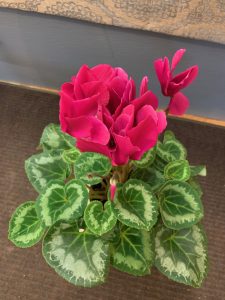Authored by: Carol Shirk
Poinsettia, amaryllis, and Norfolk Island Pine are the most common holiday gift plants. Cyclamen is a lesser known, but oft-appreciated addition to the gift giving line-up. With its brilliant blooms and marbled foliage, it has definite eye appeal. You might just become the recipient’s favorite gift-giver, even if the recipient is you.

Hardy cyclamen (Cyclamen hederifloium) is small tuberous perennial shade plant suited for outdoor gardens in our zone 5a. However, the plant typically sold around the holidays is a different species, commonly referred to as “florist’s cyclamen” (Cyclamen persicum). This plant is not suited to outdoor growth, but thrives as a houseplant.
Cyclamen are native to alpine woods in the Mediterranean region of southern Europe, western Asia, and northern Africa. In their native environment, they grow in cool conditions with annual moist and dry cycles. Having this information helps guide the care of this addition to the gardener’s repertoire.
There are 23 known species of cyclamen in the world. Breeding began in the mid-1800’s in England and the Netherlands, with the aim of producing bigger and better flowers. In the 1960’s, breeders at the University of London developed the sweet-scented, smaller bloomed flowers and attractive foliage that dominate the market today. Some cultivars also have double, crested, striped, ruffled, or frilled flowers.
Cyclamen are typically sold during the winter months because that falls during their bloom time. Plants are available in three height sizes: miniature (less than six inches), intermediate, and standard (larger that twelve inches). The bright pink, bright red, lavender, or white flower petals curve backwards from the center to resemble a butterfly or badminton birdie. The green heart shaped leaves are marbled or mottled with silver or white and are attractive on their own.
When choosing a specimen, select one with some blooms but more buds forming at the base of the plant that are preparing to open. Make sure the flower stems are standing upright and not saggy, indicating a potential problem. Look for lush, sturdy succulent foliage, absent any insect activity.
To keep cyclamen in top form, keep the temperatures on the cool side. Daytime temperatures of 60º-65º and night time of 50º are ideal, although many hybrids will tolerate a wider temperature range. However, be sure to keep them away from a heat source such as a warm draft from a furnace vent.
In order to prolong the bloom time, cyclamen like to be kept moist, but not soggy. Water thoroughly when dry, using room temperature water, and check daily. Water from either the side of the pot or from the bottom, but not from the top to prevent rotting the tuber. Keep the plant in bright indirect light and remove any spent blooms to keep the flowers blooming as long as possible.
Once blooming ceases, the leaves will yellow and fall off so that the tuber can replenish. Allow it to gradually dry out and rest for a month. Keep it in a shadier spot during the dormant season and do not water it for 6–12 weeks. Re-pot it in a well-drained soil mix after the summer dormancy period so that the upper half of the tuber is above the soil line and start watering once new leaves appear. Place back in the sunny location and wait for the blooms to reappear.
Carol Shirk
Certified Master Gardener




